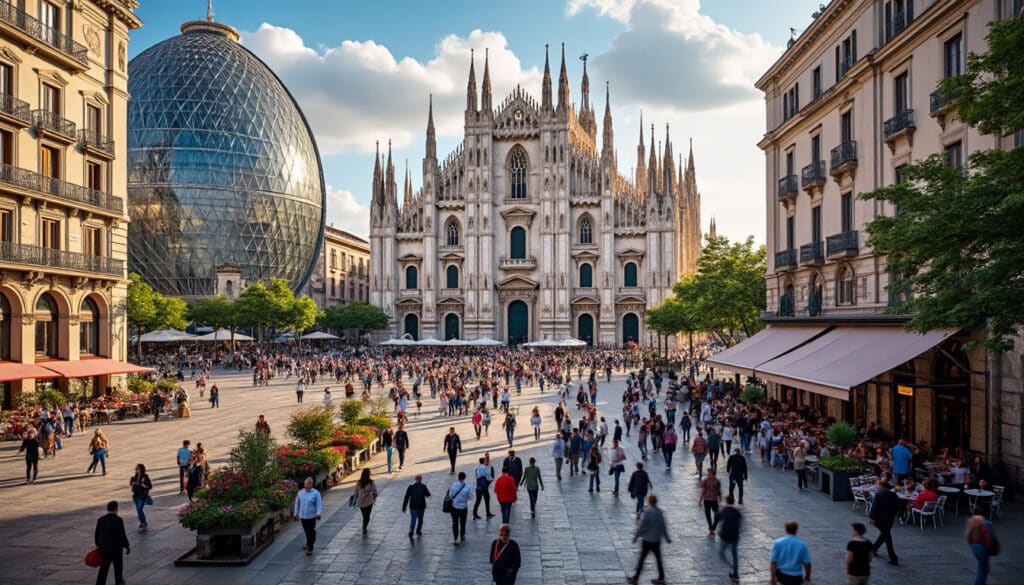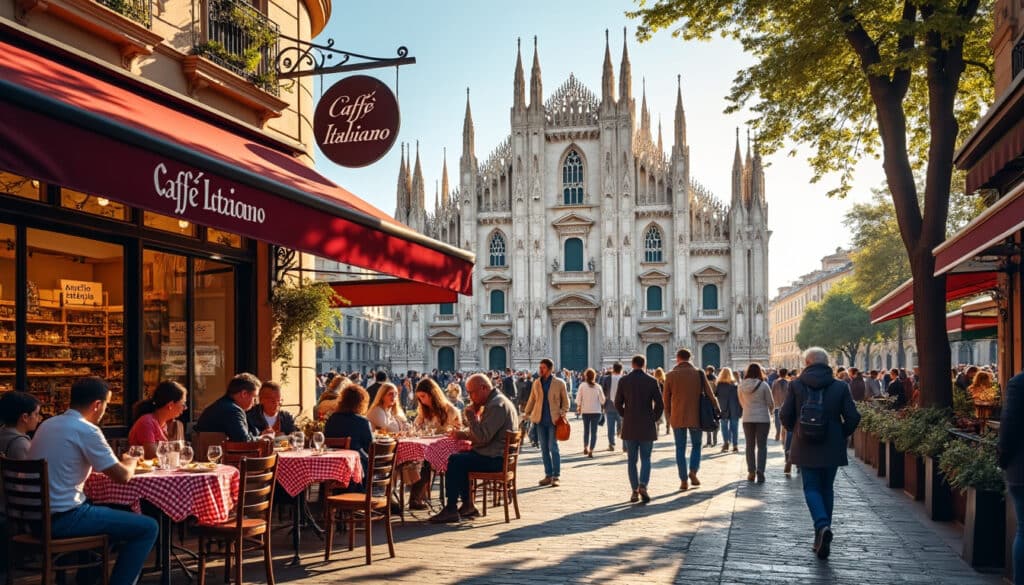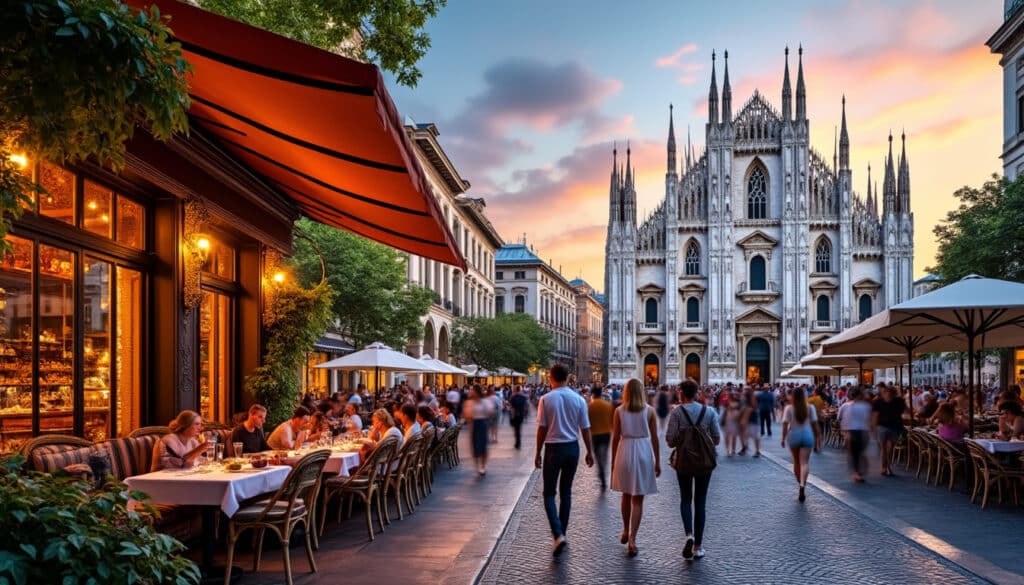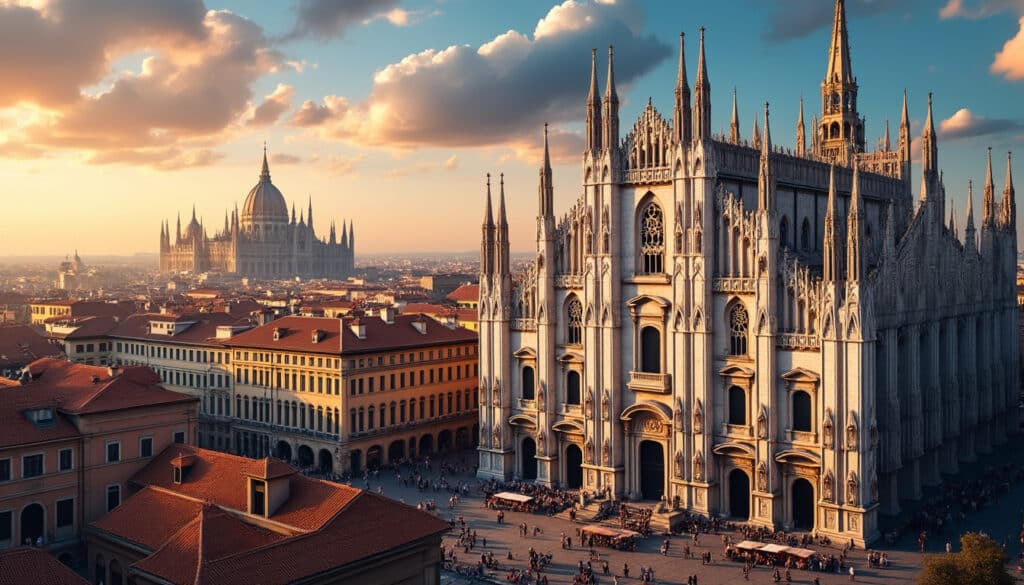Milan, a city renowned for its significant economic influence, captivating cultural history, and pioneering fashion industry, is replete with rich symbols and emblems that define its identity. From its origins as Mediolanum to its modern reputation as a global fashion hub, Milan’s evolving identity is mirrored through its names, flags, and iconic landmarks. The interplay between history and modernity is evident in the cityscape and in Milan’s cultural symbols, such as its flag and coat of arms, which narrate the city’s journey over centuries. This article explores various dimensions of Milan’s identity, focusing on key aspects like its historical insignias, architectural marvels like the Milan Cathedral, and the global brands that carry Milan’s name, including fashion giants like Prada and Versace. Through a detailed exploration into Milan’s past and present, one gains a comprehensive understanding of how this city’s identity is built upon layers of history, tradition, and innovation.
The Historic Names and Evolution of Milan’s Identity
The name Milan, historically known as Mediolanum, is rooted in its early history during the time of the Celtic Insubres tribe. This name, which translates to “in the middle of the plain,” reflects its geographical significance and strategic location in Lombardy, Italy. Over centuries, as Milan evolved from a Celtic settlement to a bustling Roman metropolis, its name became synonymous with power and prosperity. The city’s transformation further accelerated during the Renaissance under the reign of the Duke Ludovico Sforza, who brought about economic and artistic renaissance in the region.
The evolution of Milan’s identity is particularly evident in its long-standing tradition of fashion and design. Even though these aspects are modern, they are deeply entrenched in Milan’s cultural fabric, tracing back to the Renaissance period. The emergence of high-end brands such as Armani, Prada, and Dolce & Gabbana underscores how fashion is intertwined with Milan’s identity, making it a staple during international events like the Milan Fashion Week.
- Early names such as Mediolanum defined its geographical and strategic role.
- The name evolved to represent Renaissance prosperity under local ducal powers.
- Today, Milan stands as a global icon of fashion and culture.
As Milan transitioned across ages, the city has witnessed various layers of cultural and political influence, each contributing distinctively to its identity. This rich tapestry is not only a facet of its architectural landmarks like the Milan Cathedral but also through its flags and symbols that narrate a historical dialogue spanning centuries.
The Significance of Flags in Milan’s Cultural Identity
Milan’s flags carry more than decorative appeal; they are symbolic of its historical milestones and political changes. The most recognized is the red cross of St. George on a white field, introduced by the town receiving the citizenship of Milan in 930 from Archbishop Lambert. This flag has been a symbol of the Milanese identity well before the renowned Crusades.
This iconic cross has been instrumental during various historical events, notably during the Battle of Legnano where the Lombard League used it symbolically against the Holy Roman Empire. The flag represents unity and resilience, underlying themes in Milan’s historical evolution.
| Year | Symbolic Event | Flag Element |
|---|---|---|
| 930 | Adoption of Citizenship Flag | St. George’s Cross |
| 1138 | Milano Mint Established | Cross and Griphon |
| 1176 | Battle of Legnano | Strength and Unity |
Emerging from a predominantly historical context, the flag’s significance enters modern realms through its presence in sports and culture. For instance, during football matches involving AC Milan, the cross is a renewed emblem on supporters’ banners, echoing the sense of heritage and unity both locally and globally.

The Heraldry of Milan: The Coat of Arms and Beyond
The Coat of Arms of Milan is replete with symbols that narrate tales of power, influence, and sovereignty. A primary element is the Biscione, a serpent devouring a child, attributed to the Visconti family who ruled Milan from 1277 to 1397. This symbol originally derived from a mythical narrative about Ottone Visconti claiming victory over a Saracen warrior and adopting his heraldic image.
The insignia over time has served multiple purposes, moving from a symbol of intimidation and strength to a representation of power and resilience. It continues to be an emblem of Milanese culture, often reimagined in modern adaptations by Milan-based brands like Alfa Romeo and sports clubs like Inter Milan.
- Biscione: Represents domination and protection against adversities.
- Family emblems transformed into city symbols over generations.
- Resonates through modern brands and cultural representations.
The imperial eagle, joining the Biscione after Gian Galeazzo Visconti’s ascent in 1395, further encapsulates Milan’s aspiration towards Lombard sovereignty within the Holy Roman Empire. Collectively, these elements cement Milan’s historical narrative as a center of power and cultural dynamism, a facet continuously observed in its civic engagements and celebratory icons such as the modern Expo 2015.
Milan’s Architectural and Cultural Symbols
Milan’s landscape is a testament to its rich history intertwined with modern development. At the heart of the city stands the Milan Cathedral, an architectural marvel begun in 1386 and taking over 600 years to complete. The cathedral is more than a place of worship; it represents the persistence and innovation that define Milan’s character, from its elaborate Gothic design to the revered golden statue, the Madonnina.
While the Madonnina stands atop the cathedral, city regulations ensure that no structure surpasses it in height. Therefore, contemporary skyscrapers like the Pirelli Building host replicas of the Madonnina, symbolizing respect towards tradition amidst modernization. This interplay is echoed in Milan’s neighborhoods, such as the artistic Navigli Canals, blending historic charm with modern vibrancy.
| Location | Symbol | Significance |
|---|---|---|
| Milan Cathedral | Madonnina | Symbol of Protection |
| Pirelli Building | Replica Madonnina | Tradition in Modernity |
| Navigli Canals | Canal Systems | Artistic and Cultural Hub |
Milan’s cultural symbolism isn’t confined to its physical constructs. Its vigor is palpable through events like the Milan Expo, which showcases global innovation while celebrating local heritage. Moreover, the fashion runways of Versace and Dolce & Gabbana during Milan Fashion Week reflect the city’s historical narrative through modern lenses, embodying the city’s propensity for blending tradition with the contemporary.
The Role of Fashion in Defining Milan’s Modern Identity
Fashion is not just an industry in Milan but a cultural identity encapsulating elegance, innovation, and a global vision. This heritage, though prominent today, traces back to the Renaissance when the city became a melting pot of art and design. Exhibited through shows like the Milan Fashion Week, fashion has become a vital force shaping Milan’s identity, attracting designers, artists, and enthusiasts globally.
Devotees of brands like Prada or Versace witness the intertwining of history and style. For example, the flagship stores in Milan often take residence in historic buildings, creating a vibrant juxtaposition of old and new. Additionally, the Galleria Vittorio Emanuele II, housing luxury brands, stands as both a fashion landmark and a historical site.
- Iconic brands like Armani symbolize Milan’s blend of classic and modern trends.
- The Navigli district exemplifies the creative confluence of art and fashion.
- Fashion Week acts as a historical dialogue between tradition and innovation.
As fashion continues to drive commerce and culture in Milan, it reinforces the notion of the city not merely as a spectator of its history but as an active participant in shaping what modern identity can be. Emerging designers today draw from this robust narrative, ensuring Milan’s legacy in fashion remains influential and ever-evolving.
The fusion of the old-world charm with contemporary design and fashion truly embodies Milan’s spirit, where history meets modern elegance and tradition dances with innovation.
Frequently Asked Questions
- 🤔 What is the historical significance of Milan’s flag?
The flag, featuring St. George’s cross, signifies unity and resilience, rooted in historical events like the Battle of Legnano.
- 🏛️ Why is the Madonnina important to Milan?
It’s a cultural symbol signifying protection and tradition, prominently elevating Milanese identity through architectural reverence.
- 👗 How does fashion influence Milan?
Fashion is central to Milan’s identity, hosting pivotal events like Fashion Week and serving as a hub for renowned fashion houses.
- 🌍 How have Milan’s historical symbols evolved in modern times?
They evolve through reinterpretation in cultural events and are represented in modern architecture and global celebrations like Expo 2015.
- 📜 What is the significance of the Biscione in Milanese culture?
As a heraldic symbol, it signifies power and influence, historically connected to the ruling Visconti family.

Fun Facts & Curiosities About Milan
Milan, often recognized as a global beacon of style, combines its fashion-forward reputation with a deep-rooted cultural and historical tapestry. From its majestic Gothic cathedral to the vibrant hustle of Milan Fashion Week, the city is aflame with stories waiting…

Architecture and urban features of Milan
Milan, a pulsating metropolis, is celebrated not only for its unparalleled fashion sense but also for its striking architectural tapestry that paints a vivid picture of its historical evolvement and modern aspirations. Known as Italy’s design Mecca, the city offers…

Milan, a city synonymous with fashion, luxury, and culture, stands as a beacon of Italian sophistication. Nestled in the heart of Lombardia, this city is not just about runways and designer labels. Daily life in Milan merges contemporary flair with…

Demographics and geography of Milan
Milan, a bustling metropolis located in northern Italy, is not just renowned for its rich cultural heritage and fashion prestige but also for its demographic and geographic complexity. Home to some of the world’s most iconic brands such as Gucci,…

Holidays and celebrations in Milan
The vibrant city of Milan, known as Italy’s fashion and cultural hub, offers a delightful array of holidays and celebrations that reflect its rich history and modern allure. From the festive atmosphere of Milanese Holidays to the charm of Italian…

Language and spelling of Milan
Milan, a bustling metropolis located in northern Italy, is not only famous for its fashion and design shows, such as the renowned Milan Fashion Week and the acclaimed Milan Furniture Fair, but it also boasts a rich tapestry of languages…

Local tips for tourists in Milan
Milan, often celebrated as the financial and fashion heartbeat of Italy, beckons travelers with its blend of historic intrigue and contemporary flair. As the sun rises over the city’s rooftops, it casts a golden glow on architectural icons like the…

Reputation and identity of Milan
📍 Milan, the beating heart of fashion and design, has long been celebrated for its unique blend of history, culture, and modernity. As a global hub of innovation, it seamlessly marries its ancient past with its cutting-edge present, creating a…

Milan, a buzzing epicenter of fashion, culture, and history, holds a unique position in the globe not only for its iconic landmarks and vogue narratives but also for its specific place within the world’s time zones. When planning a trip…

Unusual facts and social issues in Milan
Milan, a bustling metropolis in the heart of Italy, is renowned for its chic fashion scene, rich historical tapestry, and unique cultural quirks. From Leonardo da Vinci’s incredible legacy to the iconic Milan Fashion Week, the city offers an array…

What does Milan look, smell, feel like?
Milan, a city of irresistible charm, stands on the cusp of modernity and tradition, casting a spell on anyone who dares to wander through its captivating streets. Known globally as the fashion capital, Milan is much more than its runways.…



